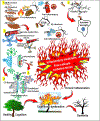The Brain AT2R-a Potential Target for Therapy in Alzheimer's Disease and Vascular Cognitive Impairment: a Comprehensive Review of Clinical and Experimental Therapeutics
- PMID: 32533467
- PMCID: PMC8109287
- DOI: 10.1007/s12035-020-01964-9
The Brain AT2R-a Potential Target for Therapy in Alzheimer's Disease and Vascular Cognitive Impairment: a Comprehensive Review of Clinical and Experimental Therapeutics
Abstract
Dementia is a potentially avertable tragedy, currently considered among the top 10 greatest global health challenges of the twenty-first century. Dementia not only robs individuals of their dignity and independence, it also has a ripple effect that starts with the inflicted individual's family and projects to the society as a whole. The constantly growing number of cases, along with the lack of effective treatments and socioeconomic impact, poses a serious threat to the sustainability of our health care system. Hence, there is a worldwide effort to identify new targets for the treatment of Alzheimer's disease (AD), the leading cause of dementia. Due to its multifactorial etiology and the recent clinical failure of several novel amyloid-β (Aβ) targeting therapies, a comprehensive "multitarget" approach may be most appropriate for managing this condition. Interestingly, renin angiotensin system (RAS) modulators were shown to positively impact all the factors involved in the pathophysiology of dementia including vascular dysfunction, Aβ accumulation, and associated cholinergic deficiency, in addition to tau hyperphosphorylation and insulin derangements. Furthermore, for many of these drugs, the preclinical evidence is also supported by epidemiological data and/or preliminary clinical trials. The purpose of this review is to provide a comprehensive update on the major causes of dementia including the risk factors, current diagnostic criteria, pathophysiology, and contemporary treatment strategies. Moreover, we highlight the angiotensin II receptor type 2 (AT2R) as an effective drug target and present ample evidence supporting its potential role and clinical applications in cognitive impairment to encourage further investigation in the clinical setting.
Keywords: AT2R agonist; Alzheimer’s disease; Angiotensin receptor blocker; Dementia; Renin angiotensin system modulator; Vascular cognitive impairment.
Conflict of interest statement
Conflict of interest
No competing financial interests exist
Figures

Similar articles
-
Brain angiotensin II and angiotensin IV receptors as potential Alzheimer's disease therapeutic targets.Geroscience. 2020 Oct;42(5):1237-1256. doi: 10.1007/s11357-020-00231-y. Epub 2020 Jul 22. Geroscience. 2020. PMID: 32700176 Free PMC article. Review.
-
Targeting brain Renin-Angiotensin System for the prevention and treatment of Alzheimer's disease: Past, present and future.Ageing Res Rev. 2022 May;77:101612. doi: 10.1016/j.arr.2022.101612. Epub 2022 Mar 26. Ageing Res Rev. 2022. PMID: 35346852 Review.
-
Renin-Angiotensin System and Alzheimer's Disease Pathophysiology: From the Potential Interactions to Therapeutic Perspectives.Protein Pept Lett. 2020;27(6):484-511. doi: 10.2174/0929866527666191230103739. Protein Pept Lett. 2020. PMID: 31886744 Review.
-
Angiotensin receptor blocker use is associated with upregulation of the memory-protective angiotensin type 4 receptor (AT4R) in the postmortem brains of individuals without cognitive impairment.Geroscience. 2023 Feb;45(1):371-384. doi: 10.1007/s11357-022-00639-8. Epub 2022 Aug 15. Geroscience. 2023. PMID: 35969296 Free PMC article.
-
RAS modulation prevents progressive cognitive impairment after experimental stroke: a randomized, blinded preclinical trial.J Neuroinflammation. 2018 Aug 13;15(1):229. doi: 10.1186/s12974-018-1262-x. J Neuroinflammation. 2018. PMID: 30103772 Free PMC article. Clinical Trial.
Cited by
-
Direct AT2R Stimulation Slows Post-stroke Cognitive Decline in the 5XFAD Alzheimer's Disease Mice.Mol Neurobiol. 2022 Jul;59(7):4124-4140. doi: 10.1007/s12035-022-02839-x. Epub 2022 Apr 29. Mol Neurobiol. 2022. PMID: 35486224 Free PMC article.
-
Role of Chrononutrition in the Antihypertensive Effects of Natural Bioactive Compounds.Nutrients. 2022 May 4;14(9):1920. doi: 10.3390/nu14091920. Nutrients. 2022. PMID: 35565887 Free PMC article. Review.
-
Candesartan Effectively Preserves Cognition in Senescence Accelerated Mouse Prone 8 (SAMP8) mice.J Alzheimers Dis Rep. 2022 Jun 2;6(1):257-269. doi: 10.3233/ADR-220016. eCollection 2022. J Alzheimers Dis Rep. 2022. PMID: 35891637 Free PMC article.
-
Alzheimer's Disease Protein Targets: Comprehensive Review and Future Directions.Curr Pharm Des. 2025;31(17):1347-1369. doi: 10.2174/0113816128334916241006195142. Curr Pharm Des. 2025. PMID: 39428938 Review.
-
Verapamil Prevents Development of Cognitive Impairment in an Aged Mouse Model of Sporadic Alzheimer's Disease.Mol Neurobiol. 2021 Jul;58(7):3374-3387. doi: 10.1007/s12035-021-02350-9. Epub 2021 Mar 11. Mol Neurobiol. 2021. PMID: 33704677
References
-
- Alzheimer’sAssociation (2020) Alzheimer’s disease Facts and Figures. Alzheimer’s Dement 16:391–460.
-
- Bhatt J, Comas-herrera AA, Amico FD, et al. (2019) World Alzheimer Report 2019 Attitudes to dementia. Alzheimer’s Disease International 1–166
Publication types
MeSH terms
Substances
Grants and funding
LinkOut - more resources
Full Text Sources
Other Literature Sources
Medical

